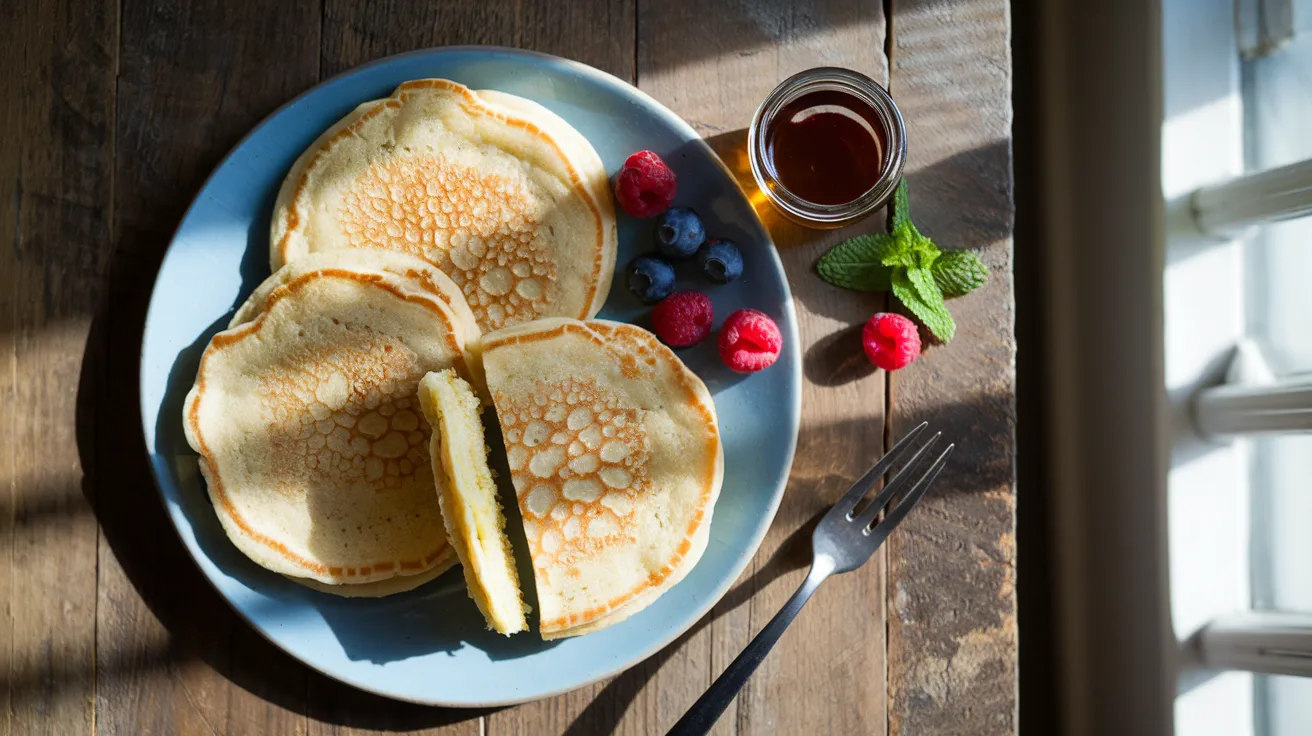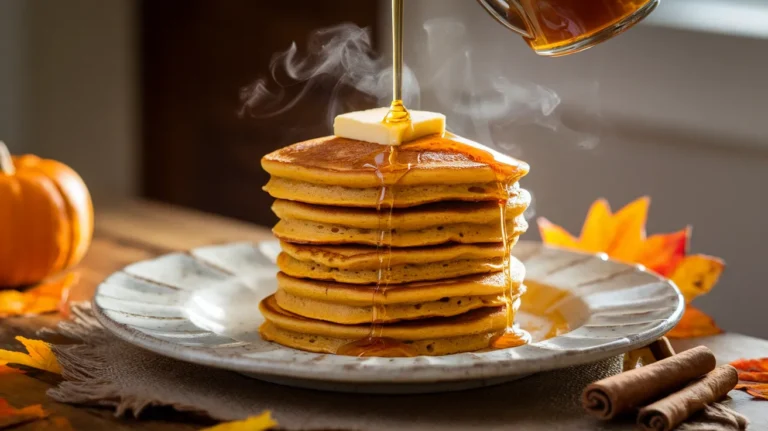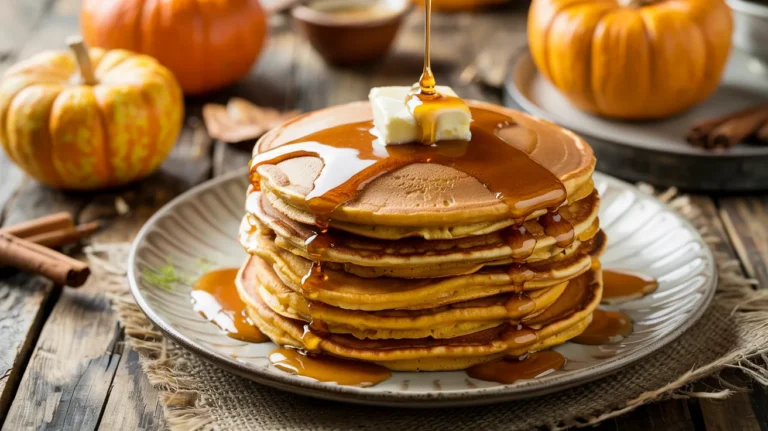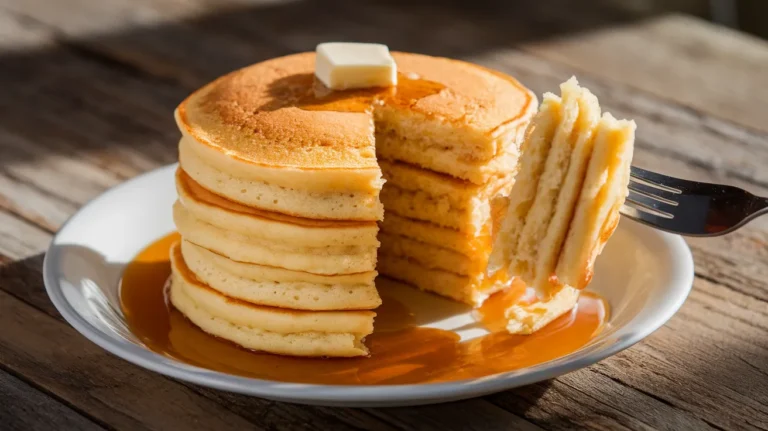- Perfect for gluten-free diets – These pancakes taste just like the real thing
- Ready in under 20 minutes – Quick enough for busy weekday mornings
- Simple ingredients – No hard-to-find items needed
- Kid-approved texture – Light, fluffy and never gritty
Are you tired of gluten-free pancakes that taste like cardboard? The search for delicious pancakes that accommodate dietary restrictions can feel impossible. Pancakes with cassava flour are the solution you’ve been searching for.
These pancakes with cassava flour solve the texture problem that plagues most gluten-free recipes. The naturally sweet, neutral flavor of cassava creates pancakes so light and fluffy, nobody will believe they’re gluten-free.
Nutrition Comparison
| Pancake Type | Calories | Carbs | Protein | Fat | Fiber |
|---|---|---|---|---|---|
| Pancakes with Cassava Flour | 210 | 32g | 3g | 8g | 3g |
| Traditional Wheat | 227 | 28g | 6g | 9g | 1g |
| Almond Flour | 254 | 12g | 8g | 20g | 4g |
| Coconut Flour | 186 | 16g | 6g | 11g | 9g |
What You’ll Need
Ingredients (Serves 4)
| Ingredient | Amount |
|---|---|
| Cassava flour | 1½ cups |
| Baking powder | 2 teaspoons |
| Salt | ¼ teaspoon |
| Ground cinnamon | 1 teaspoon |
| Eggs | 2 large |
| Milk (dairy or plant-based) | 1¼ cups |
| Vanilla extract | 1 teaspoon |
| Maple syrup | 2 tablespoons (plus more for serving) |
| Unsalted butter | 3 tablespoons, melted (plus more for cooking) |
| Fresh fruit (optional) | For serving |
Kitchen Tools
| Tool | Purpose |
|---|---|
| Large mixing bowl | For dry ingredients |
| Medium mixing bowl | For wet ingredients |
| Whisk | For combining ingredients |
| ¼ cup measuring cup | For portioning batter |
| Non-stick skillet or griddle | For cooking pancakes |
| Spatula | For flipping pancakes |
| Paper towels | For wiping pan between batches |
Substitution Options
- Milk: Any plant-based milk works well (almond, oat, coconut)
- Butter: Coconut oil makes a great dairy-free alternative
- Eggs: For egg allergies, try 2 tablespoons ground flaxseed mixed with 6 tablespoons water
- Maple syrup: Honey or agave nectar work too
Step-by-Step Instructions for Beginners
Prep Time: 10 minutes
Cook Time: 10 minutes
Total Time: 20 minutes
Preparation Phase
- Set up your workspace:
- Clear your countertop of any clutter
- Place all ingredients on one side of your workspace
- Position your stove or electric griddle within easy reach
- Set out a cooling rack or plate for finished pancakes
- Have a timer or phone ready to time the cooking
- Measure all ingredients before mixing:
- Use separate measuring cups for dry and wet ingredients
- For cassava flour: scoop into the measuring cup, then level with a knife
- For baking powder: fill the teaspoon, then level with a knife
- For salt and cinnamon: measure precisely, as too much can overpower
- Beginner tip: Place each measured ingredient in small bowls so you can double-check everything
- Prepare the eggs and milk:
- Remove eggs from refrigerator 15 minutes before using (room temperature eggs mix better)
- Warm the milk slightly (30 seconds in microwave) if it’s cold from the refrigerator
- Beginner tip: Cold ingredients don’t blend as well and can make your pancakes with cassava flour less fluffy
- Melt the butter:
- Place 3 tablespoons butter in a microwave-safe bowl
- Heat in 15-second intervals, stirring between each
- Stop when just melted (overheating can make it too hot)
- Set aside to cool slightly while you prepare other ingredients
- Beginner warning: Hot butter can cook the eggs if added directly, so let it cool for 2-3 minutes
- Prepare your pan or griddle:
- Place skillet or griddle on stovetop over medium-low heat
- Allow it to warm up gradually while you make the batter
- Beginner tip: The pan is ready when a few drops of water sizzle and dance on the surface, then evaporate within a few seconds
Making the Batter
- Combine dry ingredients thoroughly:
- Place a large mixing bowl on a stable surface
- Add 1½ cups cassava flour (make sure there are no lumps)
- Add 2 teaspoons baking powder (check expiration date – old baking powder won’t work!)
- Add ¼ teaspoon salt
- Add 1 teaspoon cinnamon
- Whisk these ingredients together for at least 30 seconds
- Beginner tip: Lift the whisk occasionally to check for unmixed pockets at the bottom of the bowl
- Prepare wet ingredients separately:
- In a medium bowl, crack 2 eggs (check for shell fragments)
- Whisk eggs until yolks and whites are fully blended (about 30 seconds)
- Add 1¼ cups milk and whisk to combine
- Add 1 teaspoon vanilla extract
- Add 2 tablespoons maple syrup
- Finally, add the cooled melted butter
- Whisk everything together until completely blended (about 1 minute)
- Beginner tip: The wet mixture should have a uniform color with no streaks of egg or butter
- Combine wet and dry ingredients carefully:
- Create a small well in the center of your dry ingredients
- Pour all of the wet ingredients into this well
- Using your whisk, start stirring from the center, gradually drawing in dry ingredients
- Mix using gentle folding motions, not vigorous stirring
- Stop as soon as no dry flour is visible (usually 10-15 strokes)
- Beginner warning: Overmixing is the #1 cause of tough, flat pancakes with cassava flour. Small lumps are actually good!
- Let the batter rest:
- Set a timer for 5 minutes and let the batter sit undisturbed
- This allows the cassava flour to absorb the liquid properly
- The batter will thicken slightly during this time
- Beginner tip: Use this time to clean up your measuring tools and prepare your cooking station
Cooking the Pancakes
- Test your cooking surface:
- Check if your pan is at the right temperature by sprinkling a few drops of water on it
- The water should sizzle gently and evaporate within a few seconds
- If it disappears instantly with a loud sizzle, your pan is too hot
- If it sits without bubbling, your pan is too cool
- Adjust heat as needed before cooking
- Beginner tip: Medium-low heat is better than high heat for pancakes with cassava flour
- Prepare the cooking surface:
- Cut a small piece of butter (about ½ tablespoon)
- Hold it with a paper towel and rub it across the hot surface
- The butter should melt immediately but not burn
- Wipe away any excess with a clean paper towel
- Beginner warning: Too much butter will make greasy pancakes; too little will make them stick
- Pour your first pancake:
- Stir the batter once gently before using
- Dip a ¼ cup measuring cup into the batter
- Fill it completely, then level it off
- Hold the measuring cup close to the pan surface (about 1 inch above)
- Pour slowly in a circular motion to form a 4-inch round pancake
- Beginner tip: Start with just ONE test pancake to check your technique and pan temperature
- Watch for cooking signs:
- Set a timer for 2 minutes
- Look for tiny bubbles to form on the surface of the pancake
- The edges will begin to look dry and slightly set
- The bottom should be golden brown (you can peek by lifting an edge with your spatula)
- Beginner tip: Resist the urge to press down on the pancake with your spatula!
- Master the perfect flip:
- Slide a thin spatula completely under the pancake
- Lift it slightly to ensure it’s not sticking
- In one quick, confident motion, flip the pancake over
- If some batter spills, don’t worry – just neaten the edges with your spatula
- Beginner warning: Hesitant flips often lead to folded or torn pancakes
- Cook the second side:
- Set timer for 1-2 minutes for the second side
- The second side cooks faster than the first
- The pancake is done when both sides are golden brown
- Test for doneness by pressing the center gently with your spatula – it should spring back
- Beginner tip: If you’re unsure if it’s done, it’s better to cook a few seconds longer than to have an undercooked center
- Cook the remaining pancakes:
- Transfer the first pancake to a plate
- Re-grease the pan lightly between each pancake
- Pour 2-3 pancakes at a time, leaving at least 1 inch between them
- Follow the same timing and flipping technique
- Beginner tip: If your pancakes with cassava flour are cooking too quickly, lower the heat slightly
- Keep pancakes warm while cooking:
- Heat oven to 200°F
- Place cooked pancakes in a single layer on an oven-safe plate
- Keep them in the warm oven while you finish cooking the remaining batter
- Beginner tip: Stacking too many hot pancakes will make them soggy, so try to arrange them with minimal overlap
Looking for more creative ways to enjoy pancakes? Check out these unique pancake ideas that will transform your breakfast routine.
Serving Suggestions
- Prepare for serving:
- Warm your serving plates in the oven for 1 minute (optional)
- Heat maple syrup in microwave for 15 seconds to serve warm
- Cut fresh fruit if using as topping
- Beginner tip: Warm plates keep your pancakes with cassava flour from getting cold too quickly
- Plate your pancakes:
- Place 3-4 pancakes on each warmed plate
- Drizzle with 1-2 tablespoons of warm maple syrup
- Add fresh fruit on top or on the side
- For a special touch, add a small pat of butter on top of the stack
- Dust with a sprinkle of powdered sugar if desired
- Serve immediately for best taste and texture
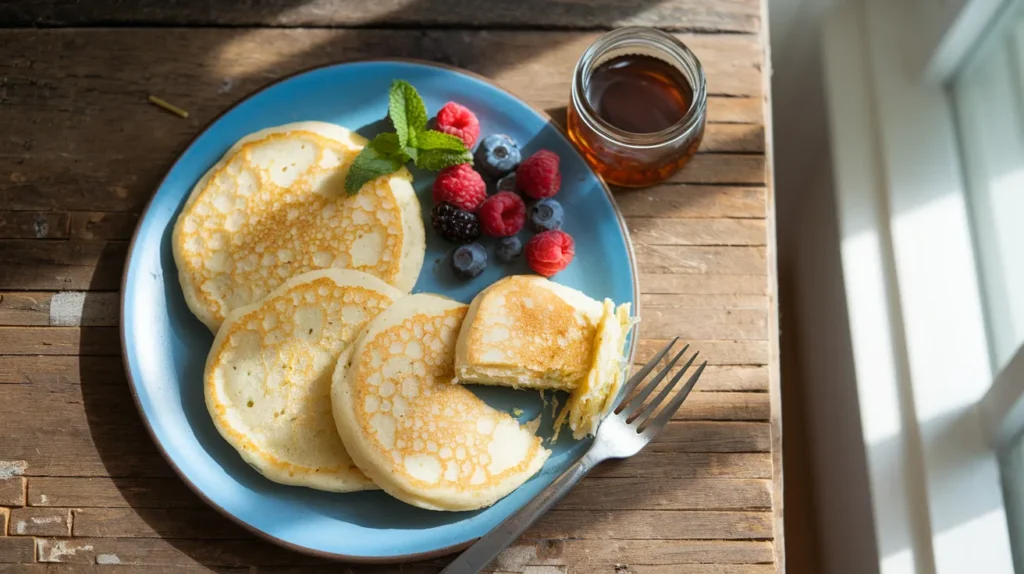
Troubleshooting Common Issues with Pancakes with Cassava Flour
Pancakes Are Too Dense
- Problem: Not enough leavening or overmixing
- Solution: Make sure your baking powder is fresh (test by putting a teaspoon in warm water – it should bubble vigorously). Avoid overmixing the batter – stop as soon as ingredients are just combined.
Batter Is Too Thick
- Problem: Cassava flour absorbs more liquid than regular flour
- Solution: Add milk, 1 tablespoon at a time, until batter reaches pourable consistency. The batter should flow slowly off a spoon, like thick honey.
Pancakes Are Burning
- Problem: Heat is too high or pan is heating unevenly
- Solution: Lower the heat and let the pan cool slightly before continuing. On electric stoves, you may need to briefly lift the pan off the heat to cool it down.
Pancakes Are Gummy Inside
- Problem: Undercooked or too much moisture in the batter
- Solution: Cook longer on lower heat. Make sure your batter has the right consistency – if it’s too wet, add 1 tablespoon of cassava flour at a time.
Pancakes Won’t Flip Cleanly
- Problem: Flipping too early or too much butter in the pan
- Solution: Wait until you see bubbles across the surface and the edges look set. Wipe excess butter from the pan between batches.
Variations & Substitutions for Pancakes with Cassava Flour
Blueberry Pancakes with Cassava Flour
Add 1 cup fresh or frozen blueberries to the batter just before cooking. If using frozen berries, don’t thaw them first – add them frozen to prevent color bleeding.
Chocolate Chip Pancakes with Cassava Flour
Fold in ½ cup mini chocolate chips to the finished batter. Add chips after the batter has rested for the best distribution.
Banana Pancakes with Cassava Flour
Add 1 mashed ripe banana (the more brown spots, the sweeter) to the wet ingredients and reduce maple syrup to 1 tablespoon. The banana adds natural sweetness.
Pumpkin Spice Pancakes with Cassava Flour
Replace ¼ cup of milk with ¼ cup pumpkin puree and increase cinnamon to 1½ teaspoons. Add ¼ teaspoon each of nutmeg and ginger for extra fall flavor.
If you’re feeling adventurous, why not try turning these pancakes into delicious pancake donuts for a fun weekend breakfast treat?
Storage & Reheating Pancakes with Cassava Flour
Refrigerator Storage
- Allow pancakes to cool completely before storing (about 30 minutes)
- Place cooled pancakes in an airtight container with parchment paper between layers to prevent sticking
- Store in refrigerator for up to 3 days
- Label container with the date for easy reference
Freezer Storage
- Place cooled pancakes in a single layer on a baking sheet and freeze until solid (about 1 hour)
- Transfer to a freezer bag with parchment paper between pancakes to prevent sticking
- Press out as much air as possible before sealing
- Label with the date and contents
- Store for up to 3 months
Reheating Methods
- Microwave:
- Place 1-3 pancakes on a microwave-safe plate
- Cover with a slightly damp paper towel
- Heat for 15-20 seconds per pancake
- Check and add more time if needed in 10-second increments
- Toaster:
- Only works well with completely thawed pancakes
- Place one pancake in each toaster slot
- Use the lowest heat setting
- Toast for 1-2 minutes, watching carefully to prevent burning
- Oven:
- Preheat oven to 350°F
- Place pancakes in a single layer on a baking sheet
- Cover loosely with aluminum foil to prevent drying
- Heat for 5-10 minutes until warmed through
- Skillet:
- Heat skillet over low heat
- Add a tiny bit of butter or oil
- Place pancakes in a single layer
- Cover with a lid
- Heat for 1-2 minutes per side
Safety Notes & Tips for Pancakes with Cassava Flour
Food Safety
- Always cook pancakes until the internal temperature reaches 165°F
- Don’t leave batter at room temperature for more than 2 hours
- Wash hands thoroughly with soap after handling raw eggs
- Clean all surfaces that come into contact with raw eggs immediately
- Refrigerate leftover batter in an airtight container if not using right away
For Perfect Results Every Time
- Don’t skip the rest time – cassava flour needs 5 full minutes to absorb liquid
- Keep pancakes warm in a 200°F oven while cooking remaining batches
- Make a test pancake to check your heat level and batter consistency
- Flip only once – too much handling makes tough pancakes
- Watch your temperature – lower heat makes more even, golden pancakes
- Use a non-stick pan if you’re a beginner – it makes flipping much easier
Enjoy these light, fluffy pancakes with cassava flour as the perfect start to your day. They’re so good, no one will guess they’re gluten-free!
